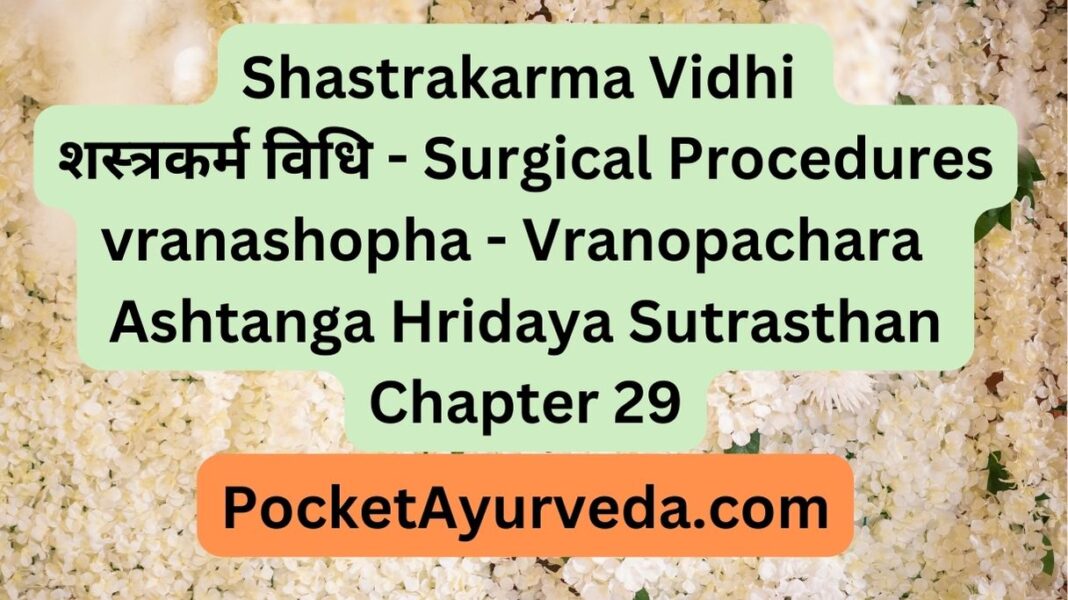Shastrakarma vidhi provides information on various surgical techniques and procedures from olden times. This chapter is chapter 29 of Ashtanga Hrudaya Sutrasthana, written by Acharya Vagbhata, his son Vaidyapathi Simhagupta. The chapter’s name will be Shastrakarma Vidhi.
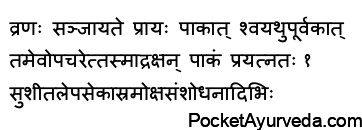

Because of the Paka (suppuration) of inflammation, Vranashotha (inflammatory ulcer) is created. Therefore, the swelling must be treated before pus formation with all methods like Susheeta lepa – the application of cold compresses.
Seka bathing the area in a cold decoction, Asramoksha – bloodletting,
Samshodhana – – Purifying Panchakarma treatments. 1.
Trividha Sopha – Three phases of swelling:
Shobha – Swelling comes in three kinds.
Ama shopha – unripe rough, the initial stage without formation of pus
Pachyamana shopha – with signs of inflammation, the first phase of pus formation. Pakva shopha – full pus development.Ama shopha.
Ama shopha – unripe inflammation
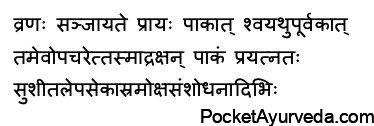

Ama shopha (unripe inflammation) is mild, with slight pain and heat. Swelling will be a similar color to the skin. The swelling will not go away.
Pachyamana shopha
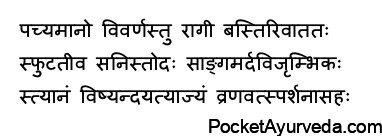

Pachyamana shopha
Vikrana – The swelling develops an entirely different color than that on the skin. Ragi is typically colored red.
Bastiriva is a bladder that expands, similar to the bladder of an animal.
Nistoda: continuous bursts of pain Angamarda – pain throughout the body
Vijrumbhika is a lot of the need to yawn,
Samrambha Different kinds of distressing symptoms Aruchi – anorexia
Daha is a burning sensation that can be felt throughout the body
Ushna – higher temperature
Trushna is a term used to describe excessive thirst.
Jvara – fever
Anidra – sleep loss,
rapid melting of solid Ghee applied to the swelling. There is an intolerance of contact – tenderness as in an ulcer 4.
Pakva Shotha – a ripe swelling
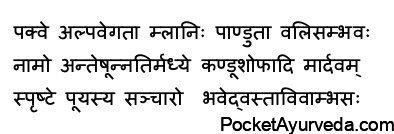

Alpa vegata is Mild
Melani is reduced in size
Panduta, white colour
Valisambhava is wrinkled on it; it is depressed throughout but elevated in the center. Kandu Itching Shopha – mild swelling
Mardava – softness,
the movement of pus can be felt by the touch, similar to water movement in the bladder. 5.
Dosha-wise symptoms of Shopha


Shula – pain due to Vata
Daha – burning sensation due to Pitta imbalance
Shopha – inflammation due to Kapha imbalance
Raga is redness and Paka – suppuration caused by Rakta viability. 6.


The growth of pus continues to increase over time; a cavity forms within the swelling. The skin thins and is damaged by Doshas. The skin is covered in black wrinkles while body hairs are shed. 7.




The predominance of Kapha causes swelling. The ripening process takes place gradually, so signs of ripening may not appear immediately, but the swelling is cold to the touch and the same color as the skin, with milled pain, and is hard to touch as if it stoned. It’s also known as Raktapaka.8 9.
Vranashopha Shastra Karma Vidhi – The procedure of surgical operation in inflammation


For those with weak brains and debilitated, as in children, or if the swelling gets larger due to the accumulation of pus, or when it’s located on joints, vulnerable spots, or joints. Treatment is,
1.Darana Darana creates an abscess that bursts through Alkalies (Kshara) application. In other situations besides the above, the treatment is
2.Sharp instruments cut off Patana. 10.
Cutting unripe swelling – Apakwa Vrana sotha
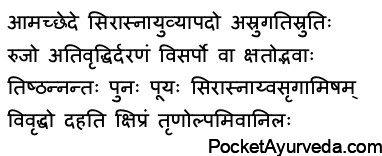

Cutting an unripe swelling causes various diseases, including the tendons and veins, massive bleeding, extreme pain, tears on the surface, or Visarpa (spreading wounds).
The pus that remains inside and growing in volume rapidly burns out the blood vessels, tendons, and muscles like sparks of fire burn away a hay pile. 11 – 12.


The surgeon who, through inexperience, cuts open an unripe swelling and ignore a mature swelling but does not cut open – both must be considered to be mean surgeons who perform arbitrary acts. 13.
Vranashopha management
Vranashopha Purvakarma – Pre-operative procedures:-




Before surgery, to open an abscess, the patient must be fed the food that they like; the person used to alcoholic drinks could be offered a glass of strong wine, which helps him feel less discomfort. 14 – 15.


Except for patients with obstructed delivery issues or renal calculus, as well as disorders of the mouth or the abdomen – these patients shouldn’t be provided with alcohol or food before the procedure. 151/2.
Vranashopha Pradhana Karma – operational procedure:-
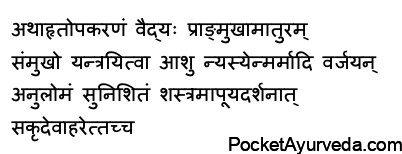

After that, keeping all equipment required, the doctor must make the patient sit facing the east, in front of him, the doctor will incise the swelling using his sharp instrument.
The incision is created in the direction of hair downwards, taking care to avoid the most vulnerable areas, deep enough until the pus is visible, and then removing the instrument swiftly. 16 – 17
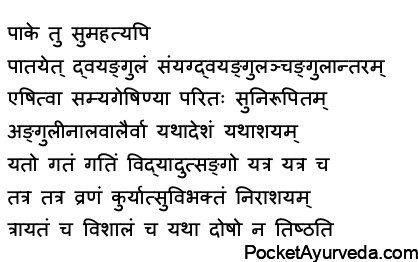

If the size of the pus production is large, The cuts can be one, three, two, or three Angula (fingers width) away;
The interior is then extracted using probe, finger, tube, or hairs of animals, depending on the area and location of the swelling.
The path to pus is established by cutting through the scar tissue, leaving a clean, large, deep wound that ensures no vitiating material remains. 18 – 20.
शस्त्र वैद्य गुण – Desired qualities of Surgeons


Shaurya – Courage,
Ashukriya is known for its speed of action
Teekshna Shastra keeps his instruments razor sharp Asveda sweats less
A path, not trembling,
Asammoha – not getting confused
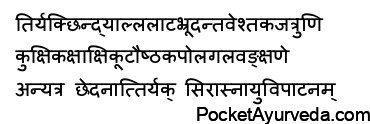

Tiryak Cheda An incision must be with a horizontal curved line in locations like the forehead, gums of the teeth, brows and shoulders and abdomen, axillae, eyes, lips, cheeks, throats, and groins. A horizontal cut elsewhere could cause cutting of veins, tendons, and so on. 22 – 23.
Sastrakarmottara Vidhi Paschat Karma – post-operative techniques
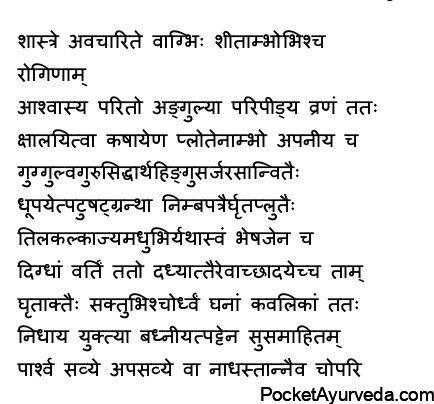

After taking off the sharp instruments, the patient is calmed by encouraging words and cold water.
The entire area around must be squeezed
The wound is cleaned with a mixture of drugs
It is possible to remove moisture by wiping cotton wool.
The wound must be smothered with the smoke from Guggulu, Aguru, Siddhartha, Hingu (Asafoetida), Sarjarasa, Patu (Salt), Sadgrantha(Acorus calamus), or leaves of Nimba (neem), which are in combination with Ghee. A wick made from a paste of Tila and honey, Ghee and the appropriate medications will be inserted into the wound. It should also be wrapped over.
A thick, ghee-based plaster made from corn flour and Ghee is placed on and bandaged with an incredibly thick piece of cloth. The cloth is wound from left to right, left or right, but it is not winding from the lower or top. 24 – 28.


The bandage cloth must be clean and thin, and the robust medicinal wick must comprise cotton threads that are soft, fumigated, and smooth, free of folds. They help to heal ulcers. 29.


Ulcers must be shielded from the invasion of harmful evils (microbes), insects, and blood-feeding flies. It is recommended to offer anointments. 30
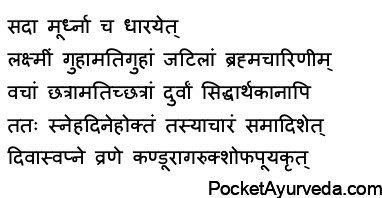

The patient must always wear his head covered with potent herbs like Lakshmi, Guha, Atiguha Jatila Brahmacharini, Vacha, Chatra, Atichatra, Durva, or Siddharthaka.
The patient should be encouraged to follow the protocol prescribed to him for the duration of the drinking oil in the context of Snehana therapy.
Sleeping during the day can cause itching, redness, swelling, pain, and pus from the ulcer. 31 – 32.


Recalling, touching, and seeing women that cause semen ejaculation can lead to negative effects from intercourse, although they aren’t a thing to indulge in. 33.


Swelling is more prominent in an ulcer due to vigorous activities. Redness can be increased when you are awake at night.
Pain by sleeping during the day;
The cause of death is the act of copulation.
Diet After surgery
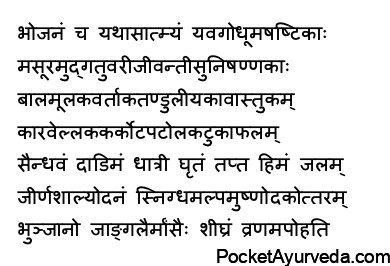

Diet after surgery
The food for the patient should be one familiar, like wheat, barley, and the ripening of rice for 60 days (swastika shali), Masura – lentil, Mudga (green-gram), Tuvari – (tur dal) Jivanti Sunisannaka delicate Mulaka (Radish), Vartaka, Tanduliyaka, Vastuka, Karavella (bitter gourd), Karkota, Patola (Pointed gourd), Katukaphala – the fruit of Katurohini, Saindhava (Black salt), Dadima (pomegranate), Dhatri (Amla), Ghrita (Ghee) and water that has been boiled and then cooled.
Dish made from old rice enriched with fats consumed in small amounts alongside meat from animals found in desert-like regions. Drinking warm water aids in the rapid recovery of wounds. 34 – 36.
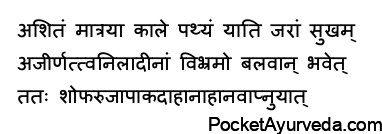

Food that should be consumed in small quantities at the correct time and healthful can be digested properly. Insomnia caused by eating too much etc. can cause problems with Vata and other doshas that could be strong enough to trigger an increase in swelling and pain, putrefaction, burning sensation, and enlargement within the stomach. 37 – 38.
Avoid eating certain foods after surgery
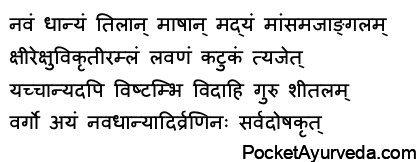

Food to be avoided after surgery
The fresh grains of the world, Tila (sesame), Masha (black grams) wine, meats other than those of animals from desert-like regions, dairy products, and sugarcane, which are salty, sour, and spicy must not be consumed;
Other substances that cause a burning sensation, constipation, or discomfort in the stomach, and is difficult to digest and can be cold;
This class of chemicals allows aggravation of all Doshas for people who suffer from ulcers. 39 – 40.


Hot, penetrating hot wines with a high percentage of alcohol. They are dry, not unctuous, and sour. They rapidly cause death in patients suffering from ulcers. 401/2.
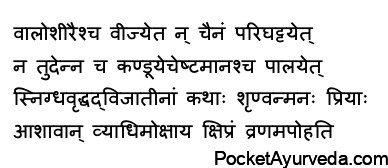

The ulcer’s site should be fanned with tufts of hairs of animals or with hairs made of Ushira (Vetiver) grass.
It should not be beaten or poked with nails. It must be shielded from harm during other activities.
A person who takes pleasure in engaging in pleasant stories and interacting with the virtuous individuals from the twice-birthed castes (Brahmin) and who is optimistic about getting rid of the disease quickly gets out of this ulcer. 41-42.
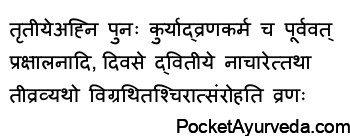

On the third day, the same treatments, like washing the ulcer, etc., are carried out, as described earlier. However, these are not to be performed on the second day because this can lead to extreme pain, the formation of tumors, and a delay in healing ulcers. 43 – 44.


The cotton threads coated with a paste of drugs and paste of drugs must not be unctuous (oily) or dry; neither should it be flabby or very thick – they should be hard and shouldn’t be placed in a way that is not appropriate;
Because unctuousness (oily and fat) can cause dryness and increase moisture. It can cause muscle tears, extreme bleeding, pain, and lacerations.
A hard, floppy, poorly put wick causes friction on an ulcer’s edges. 45 – 46.


Suppose the wick of the medicine remaining long in the ulcer causes putrefaction in the muscles, an elevated surface, tissue loss, and the accumulation of pus inside the ulcer. In that case, it should be cleaned and cleared of its contents as quickly as possible. 47.


If an unripe swelling is cut by negligence, it is best treated with poultices and food that promote ripening but are not detrimental to the wound. 48.
Sadyovrana Chikitsa Treatment of traumatized wounds
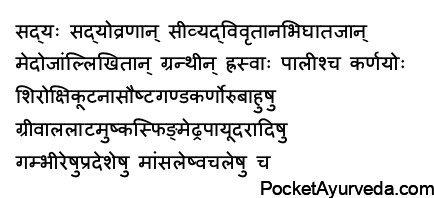

Sadyovrana Chikitsa – treatment of traumatic wounds
The wounds that are recent and large should be stitched as soon as they are discovered;
As well as the abrasions that result from scraping off fat tumors. Pinna of the ear, which are thin, and ulcers at the top of the head. Eye sockets and lips. Cheeks and ears, neck of the arms, forehead, and buttocks. The abdomen, penis, rectum, etc . must be sutured on the important immovable and fleshy organs. 49 – 50.
Wounds that shouldn’t be sutured immediately


Wounds that should not be sutured immediately
These are located on the groins, the axilla, and others, that are not as strong and mobile and ulcers that emit gas (gas) and contain foreign bodies within, created by alkalies (Akshara) as well as poisons and fire shouldn’t be sutured. 51.
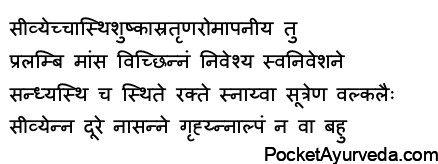

Suturing is best done after removing loose bits of bones and dried blood clots, hairs, grass, etc., and then placing the damaged and hanging pieces of muscles in their appropriate positions while keeping bones and joints broken properly and after stopping bleeding. Suturing can be done using threads of animal tendons, threads made of silk, and cotton flax. Or the inner fibers of bark from trees. Suturing should not be done too distant, close, or holding much tissue or very little. 52 – 531/2.
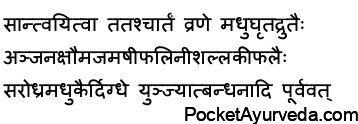

After suturing, reassuring the patient with encouraging words, a cold drink, fanning, etc. The ulcer must be covered by cotton Swabs soaked in a mixture consisting of honey, melted Ghee Anjana — Srotonjana, Ksyauma ash (flax), Phalini, the fruit that comes from Shallaki, Rodhra, and Madhuka, after which bandaging is applied and any other measures taken in the manner described previously. 54 – 55.


Edges of the ulcers that do not show bleeding must be scraped to trigger bleeding. Then suture it as blood flows because blood is the main cause and factor in healing the ulcers. 56.
Bandhana – bandages
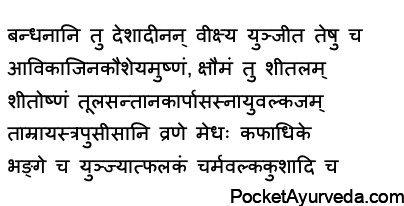

The appropriate bandages for the site of the organs in the body must be applied.
One of them is made using sheep’s skin, which is the most popular, and silk is extremely hot.
Flax bandage is cold made from cotton, silk, and tendons of animals’ sheaths, aponeuroses, and the thin layer of tendons. and the bark of trees is equally cold and hot;
wounds that are more prone to Kapha and fat must be covered by thin pieces of iron, copper zinc, or lead; similarly, fractures as well;
If fractures occur, bandaging should be performed using leather and bark from trees and splints made of hard and flat bamboo pieces or wood, metal, etc. 57 – 58.
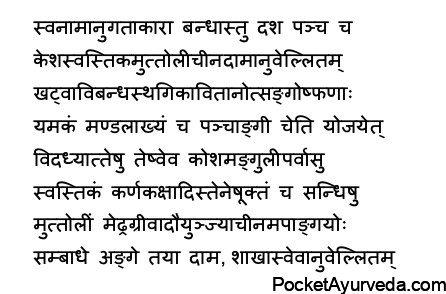

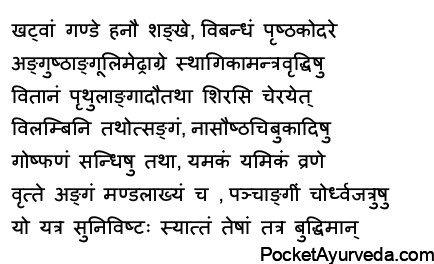

Bandages come in similar shapes as those mentioned in their names. They are fifteen in total.
They comprise Kosha, Swasthika, Muttoli, China, Dama, Anuvellita, Khatva, Vibandha, Sthagika, Vitana, Utsanga, Gosphana, Yamaka, Sthagika, Mandala and Panchangi.
Kosha type should be used for joints in fingers. The swastika for ears, Axilla etc., for joints and breasts; Mittoli for the neck, penis, etc. ;
China to treat the canthus exterior for the eye;
Dama in the junctions of body parts like the groins and so on. ; Anuvellita for the extremities,For cheeks, Khatva, jawline, and temples;
Vibandha for the abdomen and back;
Sthagika of the thumb, fingers, the tip of the penis, and in the groins, in hernia;
Vitana is a term used to describe organs that are large and also for the head.
Utsanga for hanging parts;
Gosphana for the lips, nose joints, etc.
Yamaka for areas with two ulcers adjacent to each other;
Mandala for those parts that are circular;
Pancangi for the parts that are above the shoulders.
A skilled doctor should use the type of Bandage most suitable for the area in the human body. 59 – 61.
Tight Bandage
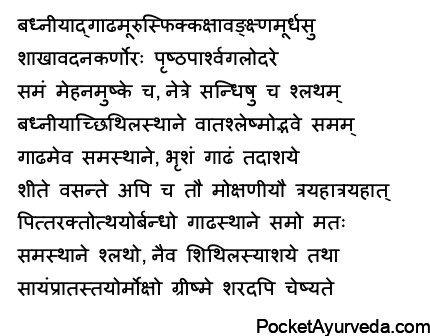

The Bandage should be secured over the buttocks, thighs, and groins. It should be tied tightly over the axillae and the head. A small pad should be on the face, extremities, chest, ears, flanks, neck, abdomen, penis, and scrotum. In places that aren’t even hard or floppy, it must be tied tight and very snug if the ulcer is in the seat – the organs of Vata or Kapha.
Moderate tight bandage: The Bandage is recommended to use a moderate bandage around the eyes, joints, areas that appear flabby, and areas where the ulcer is created through Vata and Kapha. The ulcer should be moderate. Bandages must be removed in the Sita winter and Vasanta (spring) seasons after three days.
Bandage loose Bandage must be secured moderately on the hard parts; if the wounds on them are caused due to Pitta and Rakta or on even-sized areas, the Bandage should be loose. On locations that require loose bandaging, the Bandage should not be tied in any way; during Grisma summer and Sarat the autumn season, the Bandage must be removed at night and early morning. 62 – 651/2.


If the ulcer isn’t wrapped, it can be affected by the bites of mosquitoes, cold winds, and so on. The oils and the medicines that are applied to the ulcer will not remain on the ulcer and will require a lengthy time to heal free of pus. And heal, and even after healing, it will appear discolored, and the skin over the area doesn’t get back to normal colors in the skin. 66 – 67.
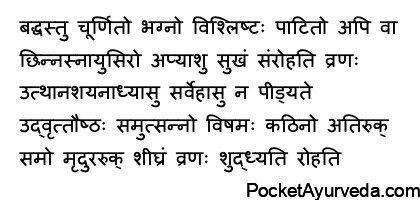

Bandaging facilitates quick and easy healing of wounds where bones are broken or crushed. Joints are dislocated and are broken up by a physician where veins and tendons are cut with bandaging; there will be no pain standing in, lying down, or other similar actions; swelling of the area of the body that are usually uneven, hard and painful, or smooth and painless – the body will be clean and heal quickly. 69.
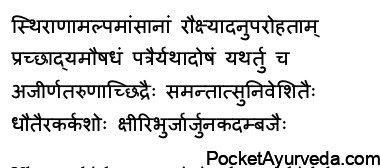

Ulcers that last for a long time with very little muscular tissue that doesn’t heal until dryness and lack of moisture should be treated with medicines wrapped in the leaves of trees according to the Doshas in question and the seasons. The leaves should not be mature but tender and young with no holes that are in any way bad clean and not rough. They should belong to trees with milky sap Bhurja, Arjuna, or Kadamba. 70 – 71.
Bandaging contra indication –
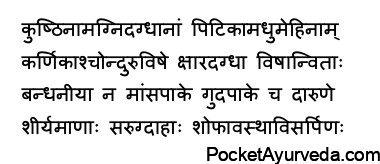

Bandaging contra indication
The use of bandaging is not recommended to treat ulcers that are caused by burns caused by fire or leprosy from diabetes mellitus or rat bites, burned by alkalies caused by poison, which cause putrefaction in the muscles and severe ulcerations of the rectum and are growing by losing tissues that are painful and feel burning and that remain inflamed for a long time and can spread to other areas. 72 – 73.
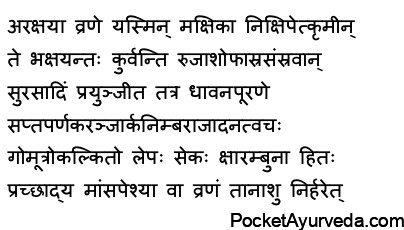

Flies deposit worms – bacteria, etc., within the ulcers, which bandaging cannot protect. Bacteria that eat the tissue create pain, swelling, and bleeding. To wash and fill ulcers, the medications of Surasadigana in Chapter 15 must be used. Rajadana is made with cow urine. Bathing the ulcer with an alkali solution can be beneficial, as is scarification of muscle tissue through these methods, the worms, bacteria, and so on. It must be eliminated quickly. 74 – 76.


A rush to heal the ulcer contaminated by Doshas inside is not recommended because it could get worse even with a slight mishap. 77.


Once the ulcer is healed, the patient should stay clear of physical and mental activities, indigestion, copulation and anger, as well as fear, and so on. until he reaches his maximum capacity, he should live an orderly life, for at the very least six or seven weeks. 78 – 79.


These other ailments that show need to be treated with methods suitable to the strengths of the Doshas, etc. Based on the context of the information provided in the Uttara Tantra, this treatise’s last section (vide chapters 25-27) is 80.
This chapter is titled Shastrakarma Vidhi, The 29th chapter of Sutrasthana of Astangahridayam.


